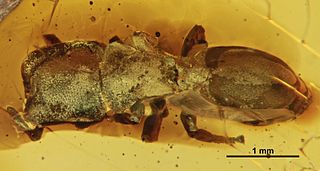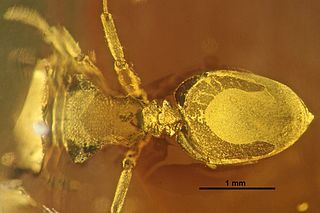
Cephalotes is a genus of tree-dwelling ant species from the Americas, commonly known as turtle ants. All appear to be gliding ants, with the ability to "parachute" and steer their fall so as to land back on the tree trunk rather than fall to the ground, which is often flooded.

Cephalotes alveolatus is an extinct species of ant in the subfamily Myrmicinae known from a single Middle Miocene fossil found in amber on Hispaniola. At the time of description C. alveolatus was one of seven fossil ant species placed in the Cephalotescoffeae clade.

Cephalotes caribicus is an extinct species of ant in the subfamily Myrmicinae known from two Middle Miocene fossils found in amber on Hispaniola. At the time of description C. caribicus was one of nine ant species placed in the Cephalotespinelii clade.

Cephalotes dieteri is an extinct species of ant in the subfamily Myrmicinae known from two Middle Miocene fossils found in amber on Hispaniola. At the time of description, C. dieteri was one of seven fossil ant species placed in the Cephalotescoffeae clade.

Cephalotes integerrimus is an extinct species of arboreal ant of the genus Cephalotes, characterized by an odd shaped head and the ability to "parachute" by steering their fall if they drop off of the tree they're on. Giving their name also as gliding ants. Their larger and flatter legs, a trait common with other members of the genus Cephalotes, gave them their gliding abilities.

Cephalotes jansei is an extinct species of arboreal ant of the genus Cephalotes, originally erroneously called Exocryptocerus jansei by its discoverers, characterized by an odd shaped head and the ability to "parachute" by steering their fall if they drop from a tree, giving them the nickname of gliding ants. The species was probably native of Hispaniola, however, lack of more evidence makes this uncertain. Their larger and flatter legs, a trait common with other members of the genus Cephalotes, gave them their gliding abilities.
Cephalotes maya is an extinct species of arboreal ant of the genus Cephalotes, characterized by an odd shaped head and the ability to "parachute" by steering their fall if they drop off of the tree they're on. Giving their name also as gliding ants. The species was probably native of the Mexican state of Chiapas, however, lack of more evidence makes this uncertain. Their larger and flatter legs, a trait common with other members of the genus Cephalotes, gave them their gliding abilities.

Cephalotes nilpiei is a species of arboreal ant of the genus Cephalotes, characterized by an odd shaped head and the ability to "parachute" by steering their fall if they drop off of the tree they're on. Giving their name also as gliding ants. The species is native of the Brazilian states of Minas Gerais and Rio de Janeiro. Their larger and flatter legs, a trait common with other members of the genus Cephalotes, gives them their gliding abilities and eases their arboreal movement.
Cephalotes obscurus is an extinct species of arboreal ant of the genus Cephalotes, characterized by an odd shaped head and the ability to "parachute" by steering their fall if they drop off of the tree they're on. Giving their name also as gliding ants. The species was probably native to Hispaniola, however, lack of more evidence makes this uncertain. Their larger and flatter legs, a trait common with other members of the genus Cephalotes, gave them their gliding abilities.

Cephalotes hispaniolicus is an extinct species of ant in the subfamily Myrmicinae known from a single Middle Miocene fossil found in amber on Hispaniola. At the time of description C. hispaniolicus was one of six ant species placed in the Cephalotesmultispinosus clade.

Anochetus ambiguus is an extinct species of ant in the subfamily Ponerinae known from two possibly Miocene fossils found on Hispaniola. A. ambiguus is one of eight species in the ant genus Anochetus to have been described from fossils found in Dominican amber and is one of a number of Anochetus species found in the Greater Antillies.
Anochetus brevidentatus is an extinct species of ant in the subfamily Ponerinae known from two possibly Miocene fossils found on Hispaniola. A. ambiguus is one of eight species in the ant genus Anochetus to have been described from fossils found in Dominican amber and is one of a number of Anochetus species found in the Greater Antillies.

Anochetus conisquamis is an extinct species of ant in the subfamily Ponerinae known from one possibly Miocene fossil found on Hispaniola. A. conisquamis is one of eight species in the ant genus Anochetus to have been described from fossils found in Dominican amber and is one of a number of Anochetus species found in the Greater Antilles.

Anochetus corayi is an extinct species of ant in the subfamily Ponerinae known from one possibly Miocene fossil found on Hispaniola. A. corayi is one of eight species in the ant genus Anochetus to have been described from fossils found in Dominican amber and is one of a number of Anochetus species found in the Greater Antillies.

Anochetus dubius is an extinct species of ant in the subfamily Ponerinae known from two possibly Miocene fossils found on Hispaniola. A. dubius is one of eight species in the ant genus Anochetus to have been described from fossils found in Dominican amber and is one of a number of Anochetus species found in the Greater Antillies.

Anochetus exstinctus is an extinct species of ant in the subfamily Ponerinae known from two possibly Miocene fossils found on Hispaniola. A. exstinctus is one of eight species in the ant genus Anochetus to have been described from fossils found in Dominican amber and is one of a number of Anochetus species found in the Greater Antillies.

Anochetus intermedius is an extinct species of ant in the subfamily Ponerinae known from two possibly Miocene fossils found on Hispaniola. A. intermedius is one of eight species in the ant genus Anochetus to have been described from fossils found in Dominican amber and is one of a number of Anochetus species found in the Greater Antilles.

Anochetus lucidus is an extinct species of ant in the subfamily Ponerinae known from two possibly Miocene fossils found on Hispaniola. A. lucidus is one of eight species in the ant genus Anochetus to have been described from fossils found in Dominican amber and is one of a number of Anochetus species found in the Greater Antillies.

Aphaenogaster amphioceanica is an extinct species of ant in the subfamily Myrmicinae known from a single possibly Miocene fossil found in amber on Hispaniola. At the time of description A. amphioceanica was one of two Aphaenogaster species known from the Caribbean islands.
Aphaenogaster praerelicta is an extinct species of ant in the subfamily Myrmicinae known from a solitary Late Oligocene to Early Miocene fossil found in Mexico. At the time of description A. praerelicta was one of three Aphaenogaster species known from Mexico.















